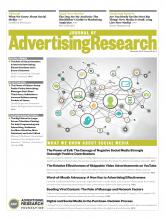Click on the PDF link for the complete article.
ABSTRACT
Online viral campaigns require a seeding strategy that involves choosing the first-generation consumers to spread a viral message to. Building on social-capital theory and social-network analysis, this research examines key aspects of the seeding strategy by tracking the diffusion of 101 new videos published on YouTube. The results show that the need for a “big-seed” strategy (i.e., using many seed consumers) depends on message quality. Furthermore, one should choose consumers who have strong ties with the advertiser and who also have strong influence on others, rather than simply wider reach. Among seed consumers, they should share a moderate amount of interest overlap instead of being too homogeneous or heterogeneous as a group.
- © Copyright 2012 The ARF. All rights reserved.





